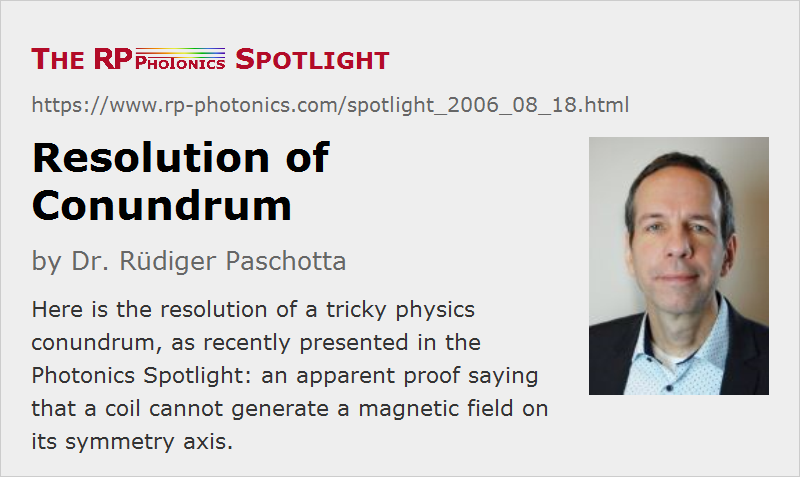Resolution of Conundrum
Posted on 2006-08-18 as part of the Photonics Spotlight (available as e-mail newsletter!)
Permanent link: https://www.rp-photonics.com/spotlight_2006_08_18.html
Author: Dr. Rüdiger Paschotta, RP Photonics AG, RP Photonics AG
Abstract: Here is the resolution of a tricky physics conundrum, as recently presented in the Photonics Spotlight: an apparent proof saying that a coil cannot generate a magnetic field on its symmetry axis.

Here is the resolution of a tricky physics conundrum, as recently presented in the Photonics Spotlight: an apparent proof saying that a coil cannot generate a magnetic field on its symmetry axis.
Some people suspected that this strange issue is related to some subtleties associated with the concept of infinity – field lines going to infinity might leave some room for surprises. However, the resolution is really not that subtle: it is the uncovering of a simple mathematical trick. It is true that the magnetic field strength has no x and y components on the symmetry axis, but from that we cannot conclude that <$\partial B_x / \partial x = \partial B_y / \partial y = 0$>. Therefore, <$\partial B_z \ / \partial z$> doesn't have to be zero, and the whole argument breaks down. At least in this case, we don't have to rewrite the textbooks!
It is surprising how easily one falls into this trap. It happened to professors (not stupid ones), so never mind if it happened to you!
This article is a posting of the Photonics Spotlight, authored by Dr. Rüdiger Paschotta. You may link to this page and cite it, because its location is permanent. See also the RP Photonics Encyclopedia.
Note that you can also receive the articles in the form of a newsletter or with an RSS feed.
Questions and Comments from Users
Here you can submit questions and comments. As far as they get accepted by the author, they will appear above this paragraph together with the author’s answer. The author will decide on acceptance based on certain criteria. Essentially, the issue must be of sufficiently broad interest.
Please do not enter personal data here; we would otherwise delete it soon. (See also our privacy declaration.) If you wish to receive personal feedback or consultancy from the author, please contact him, e.g. via e-mail.
By submitting the information, you give your consent to the potential publication of your inputs on our website according to our rules. (If you later retract your consent, we will delete those inputs.) As your inputs are first reviewed by the author, they may be published with some delay.


Connect and share this with your network:
Follow our specific LinkedIn pages for more insights and updates: